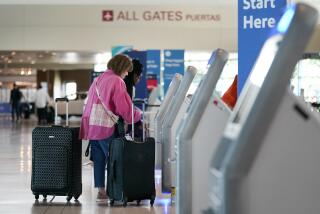Airline Deregulation: Has It Really Worked? : While some travelers get lost in a maze of restrictions, others are able to fly more often on discounted fares.
- Share via
WASHINGTON — After more than a decade of airline deregulation, arguments are raging among experts, consumers and government officials about how well deregulation has worked.
In fact, there is only one thing that everybody agrees on: Nobody thought that lifting government controls would turn out quite the way it has.
BACKGROUND: When the airline industry was deregulated in 1978, the hope was that allowing carriers to set prices and routes without government supervision would stimulate competition, drive down fares, increase the number of flights and make air travel accessible to more people.
Although deregulation has resulted in more airplanes flying more people to more cities, often at discount fares, it has also resulted in fewer nonstop flights, poor service, a maze of fare restrictions and ticket prices that range from bargains to rip-offs. The industry has been attacked for losing luggage, crowding passengers onto dirty airplanes and causing delays by scheduling too many flights at peak hours.
Meanwhile, many airlines have gone bankrupt or have been swallowed up by larger carriers. Between 1978 and 1988, there were more than 150 bankruptcies and 50 mergers. Deregulation did stimulate competition as new or smaller carriers cut fares, but a small group of large airlines drove most of them out of business by matching or beating prices. Today, three airlines control more than half the U.S. market.
Whether or not deregulation was a good move depends on which consumers you ask.
PRO: Clifford Winston, a senior fellow at the Brookings Institution, contends that deregulation has lived up to its promise of more flights, increased air travel and cheaper fares, with about 90% of passengers now flying on some sort of discounted ticket.
“Your life would be a hell of a lot worse if we were still under regulation and deregulation had never been born,” he said.
Deregulation has given airline passengers a whole new world of choices of prices and kinds of services, says Randy Petersen, publisher of Frequent, a magazine for frequent flyers. That in turn enables airlines to build customer brand loyalty--a concept that didn’t exist before.
At the same time, Petersen says, the elimination of government regulation has finally led to true competition among airlines, with one carrier frequently matching discounts offered by another, keeping the fares competitive. “If nothing else, that’s great,” he says.
Ed Perkins, editor of the monthly Consumer Reports Travel Letter, agrees. Deregulation has been beneficial overall and has achieved its goal of increased competition, Perkins asserts. “The bottom line is that no single airline is reflecting anything like monopoly profits.”
Perkins adds that where there is competition, there are attractive fares--at least for some of the people, some of the time.
CON: But Perkins also agrees with critics who charge that for every passenger who flies at a discount, someone else is paying the difference.
Daniel Smith, an officer of the Airline Passengers Assn. of North America, which represents business travelers, said that the corporate traveler often falls into this second category.
Pleasure travelers usually can make reservations two or three weeks in advance--and stay over a Saturday night--to receive the lowest fares, but the business traveler who has to fly at a moment’s notice may pay two to three times the discount price, Smith noted.
Paul Stephen Dempsey, director of the Transportation Law Program at the University of Denver College of Law, maintains that the business passenger does not benefit from greater flight frequency either.
“If you have the 3:15 flight and your ticket is non-refundable, you have to stick around even if your business is done at 9 a.m.,” Dempsey complained.
“The restrictions (to attain low fares) are maddening,” he added. “You have to purchase your ticket 21 days in advance, stay over on a Saturday and give the airline your first-born child.”
In a report for the Economic Policy Institute, a Washington research group, Dempsey found that airline prices average 2.6% more per mile under deregulation and that the cost per trip may be up to 33% higher because of the circuitous routing under the new regional hub system.
OUTLOOK: Despite criticism, it looks as though deregulation is here to stay--at least for now. Congress considered re-regulating the industry in 1989 but since then has dropped the issue. Meanwhile, the industry is continuing to shrink and struggle financially.
Where They Are Now
Market share of major domestic airlines before and after deregulation. Figures are percent of paid passenger miles.
Airline 1978 1991 American 12.8% 17.7% United 17.4 17.4 Delta 10.3 15.5 Northwest 3.1 11.4 Continental/Texas Air 3.8 9.6 USAir 1.8 8.3 TWA 10.2 5.7 Pan Am 10.7 5.2
Source: Paul S. Dempsey, University of Denver
More to Read
Inside the business of entertainment
The Wide Shot brings you news, analysis and insights on everything from streaming wars to production — and what it all means for the future.
You may occasionally receive promotional content from the Los Angeles Times.










